Reproductive health care for adolescents with disabilities requires special consideration
Despite a painful history, equitable care is imperative
According to the Centers for Disease Control and Prevention (CDC), there are over 12 million children and adolescents aged 3 to 17 years with a diagnosed developmental disability.1 This number is growing, with the CDC reporting an increased incidence of developmental disabilities in children and adolescents from 16.2% between 2009 and 2011 to 17.8% between 2015 and 2017.2 Although adolescents with disabilities make up a significant portion of obstetricians and gynecologists’ patient panels, specific training on the best care for this population is often lacking.3
The reproductive health care of adolescents with disabilities has been fraught with a painful history—including forced sterilization, which has lasting impacts on patients to this day. A recent study found that 15- to 40-year-old females with physical or sensory disabilities are at an increased risk of sterilization (odds ratio, 1.36; CI, 1.03-1.79) after adjusting for age, race, ethnicity, marital status, insurance, parity, and self-reported health.4 Additionally, the disproportionate incidence of sexual violence against children with disabilities is staggering.5 Recent research suggests that children with disabilities are 3 times as likely to experience sexual violence as those without disabilities, with the highest rates of violence occurring between aged 12 and 15 years.6,7 Furthermore, adolescents with disabilities receive inadequate sexual education and counseling regarding contraception and experience higher rates of sexually transmitted infection and unplanned pregnancy.5 Finally, even in the past 2 decades, it has been well documented that patients with disabilities are less likely than their peers to receive appropriate breast and cervical cancer screening.8 Figure 1 provides a comprehensive description of the sexual and reproductive health disparities that affect adolescents with disabilities. It is imperative that providers better understand how to care for this patient population so that all patients are treated with the dignity, respect, and compassion they deserve.
FIGURE 1. Reproductive Health Disparities in Adolescents
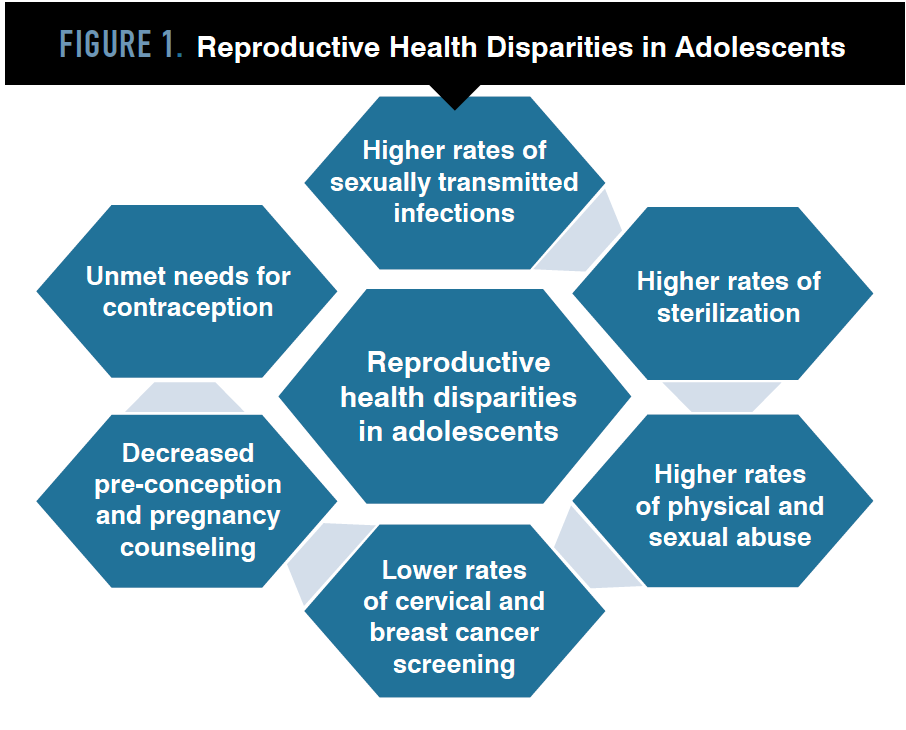
General approach to patients with disabilities
According to the American College of Obstetricians and Gynecologists (ACOG), “excellent gynecologic health care for women and adolescents with disabilities is comprehensive; maintains confidentiality; is an act of dignity and respecttoward the patient; maximizes the patient’s autonomy; avoids harm; and assesses and addresses the patient’s knowledge of puberty, menstruation, sexuality, safety, and consent.”9As demonstrated in Figure 2, adolescent women with disabilities face several interrelated barriers to this excellent gynecologic health care.
FIGURE 2. Barriers to Accessing Health Care for Adolescents With Disabilities
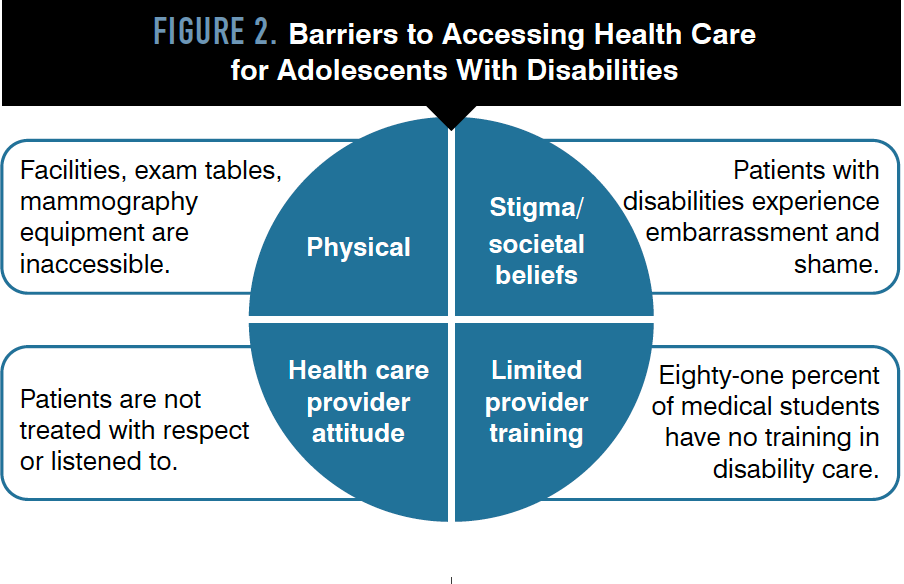
Many of the most critical aspects of providing quality care to adolescents with disabilities are not groundbreaking techniques but rather, common-sense practices that empower patients to be active participants in their own health care. It is imperative that the provider assess the patient’s competence and ability to communicate without making assumptions that caregivers should speak on behalf of the patient. This can sometimes be met with discomfort from well-intentioned families who are accustomed to having a large amount of control over an adolescent’s life. However, it is essential to provide health care in a way that gives maximal autonomy to the patient based on age and level of competence—not the comfort of family members.
Speaking directly with patients in an adult tone and working to establish familiarity and rapport can also improve care in patients with disabilities. Furthermore, it is beneficial to ask adolescents how they communicate best and be willing to engage with assistive devices. It is crucial to provide an environment that minimizes sensory strain for patients with intellectual disabilities to promote engagement. It is also necessary to assess the physical disability of adolescents and pursue creative options to ensure that they have equitable access to gynecologic exams and procedures if they are indicated.
The physical, mental, and emotional changes that adolescents with disabilities experience during puberty will be largely similar to those of their nondisabled peers. It is important to normalize and anticipate these changes with patients and their families in addition to understanding the special considerations discussed below.
Special considerations in this population
For most adolescents with disabilities, the process and pattern of menstruation vary little from those of their peers. No matter the timing of puberty, ideal sexual health care of adolescents with disabilities involves anticipatory guidance that begins before menarche, when breast development begins.
Specific disabilities that can be anticipated to affect the tempo and timing of puberty include Prader-Willi syndrome and spina bifida. Patients with Prader-Willi syndrome often experience delayed or incomplete puberty with sustained irregular menstruation.10 Patients with spina bifida, especially those with myelomeningocele, may experience central precocious puberty and require prompt referral to a pediatric endocrinologist to minimize unwanted side effects.11 There is conflicting evidence on the timing of puberty in adolescents with autism spectrum disorder (ASD), with a recent study suggesting that there is no statistically significant difference in pubertal timing for adolescents with ASD compared with the rest of the population.12
During puberty, patients may have an increased sense of separation from their peers, which can result in challenges with friendships and social isolation.13 Normal mood changes during puberty may be especially challenging for patients with disabilities, who may already be struggling with emotional regulation, communication, and age-appropriate behavior.
Menses Management
Physical interventions required for monthly menstruation, such as pads or tampons, might be difficult or impossible for adolescents with certain disabilities to use. Menstrual suppression is therefore one of the most common reasons patients with disabilities seek gynecologic care. In a retrospective study of 300 adolescents with developmental disabilities ranging in age from 7 to 19 years, the main reason patients sought care was menstrual suppression, followed by hygiene and caregiver burden14 (Figure 3).Patients with cognitive or physical impairments who make appointments for pubertal anticipatory guidance typically present 13.5 months prior to menarche,15 with more than half of families describing potential behavior changes as their main concern.
Figure 3. Concerns Surrounding Menstrual Suppression in Adolescents With Disabilities
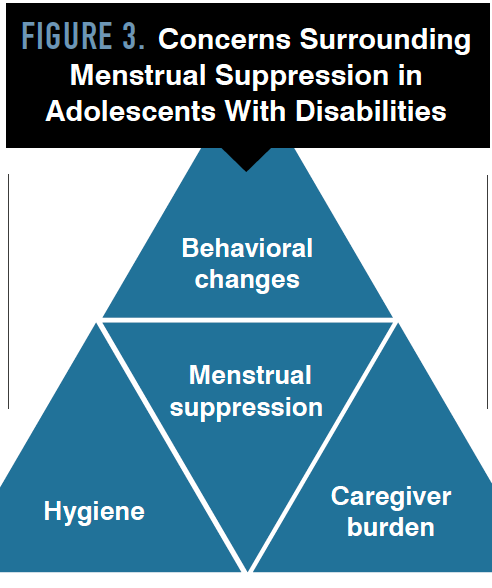
It is important to note that menstrual suppression is not recommended prior to menarche, according to ACOG’s Committee on Adolescent Healthcare.9 As with all patients, menstrual suppression plans should be individualized following discussion of all options (pill, patch, ring, shot, implant, intrauterine device [IUD]) and elucidation of adolescent preference. Families will sometimes ask about surgical options for menstrual suppression (hysterectomy) but these should be reserved only for medically indicated reasons such as cancer or when all other treatment options have been exhausted. According to ACOG, endometrial ablation is never recommended for menstrual suppression in adolescents.
Setting expectations with families is a crucial component of menstrual management for adolescents with disabilities. Families may be unaware that surgical treatment to permanently end menses will not affect the mood changes that occur with menses. Additionally, it is important to emphasize that complete amenorrhea may be difficult to achieve with medical management. All menses management methods have benefits and drawbacks; see Figure 4 for an overview of factors to consider when deciding on the best method to use.
FIGURE 4. Considerations in Menses Management Options for Adolescents with Disabilities
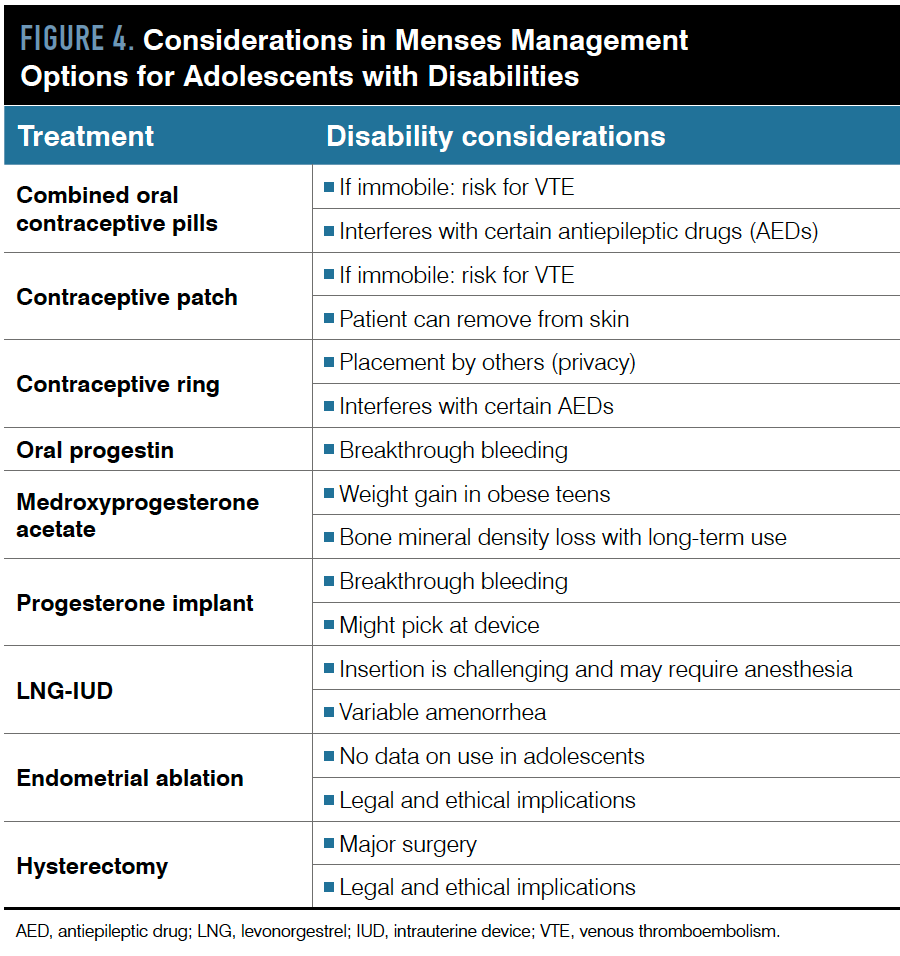
Previously, the most popular contraceptive method for adolescents with disabilities was depot medroxyprogesterone acetate (DMPA) because of its injection form and possible resultant amenorrhea with long-term use.13 However, because DMPA is associated with loss of bone mineral density, other forms of contraception without this side effect are often considered first line today. Oral contraceptive pills (OCPs), hormonal transdermal patches, and levonorgestrel IUDs are safe and common agents for menstrual suppression in adolescents with disabilities.14 Amenorrhea is often achieved via continuous hormone therapy (with OCPs or transdermal patches) or levonorgestrel IUD placement. In a 2021 study, of 30 patients with disability who desired hormonal management of menses, 30% had an IUD placed, 30% chose OCPs, and 20% chose oral progestin. Ninety-six percent were satisfied with their final bleeding pattern and 50% achieved amenorrhea.15 The remaining 20% of patients who chose not to begin hormonal management of menses demonstrate that providing education and resources prior to menarche can equip patients and their families to manage menses without medication.
It is important to mention the small but well-supported increased risk of venous thromboembolism (VTE) with estrogen-containing contraceptive methods. The population of adolescents with disabilities includes many with limited mobility, wheelchair dependence, or other baseline risk factors for VTEs. Data from 2019 suggest that patients with cerebral palsy are at an increased risk of VTE whether they are ambulatory or not.16 Although VTE is incredibly rare in adolescents (estimated 0.07/10,000 children < aged 18 years),17 we recommend weighing each patient’s specific risk factors and opting for progestin-only options for menses management in patients with multiple risk factors.
According to ACOG’s practice bulletin on noncontraceptive uses of hormonal contraceptives, data show that levonorgestrel IUD placement and endometrial ablation have similar reductions in menstrual blood loss up to 24 months, supporting the effectiveness of IUDs in menses suppression.18 IUD insertion can prove more challenging in adolescents with disabilities, however, sometimes requiring intravenous (IV) sedation or general anesthesia in the operating room (OR) for placement. A recent study looking at 159 females under 22 years who had disabilities found that of 189 IUDs placed in this population over 10 years, 96% of insertions were done in the OR. Continuation rates were high, with 95% of patients keeping their IUD at 1 year and 73% at 5 years.15 It is also not uncommon to combine IUD insertion with other medical procedures requiring IV sedation or the OR. Cervical cancer screening (Papanicolaou test) at the time of insertion is recommended
if appropriate.
Sexual Health Education
Sexual health education can be challenging and uncomfortable for all adolescents, and this is no different for patients with disabilities. For centuries, incorrect beliefs about adolescents with disabilities, including a presumed lack of sexual desire/activity, and lifelong infantilization led to neglect of sexual health in this population. Sexuality education is still often overlooked in this population, and adolescents with disabilities receive far less of it than their peers despite being at an increased risk of poor sexual health.19
Discussions with patients can help providers assess patient understanding, knowledge, and attitude toward sex and sexual development. Providers should educate adolescents on a wide variety of topics, including the anatomic and physiologic changes of puberty, sex and sexual development, gender identity, healthy relationships, safe online practices, consent, and sexual abuse (Figure 5).
FIGURE 5. Components of Sexual Health Education
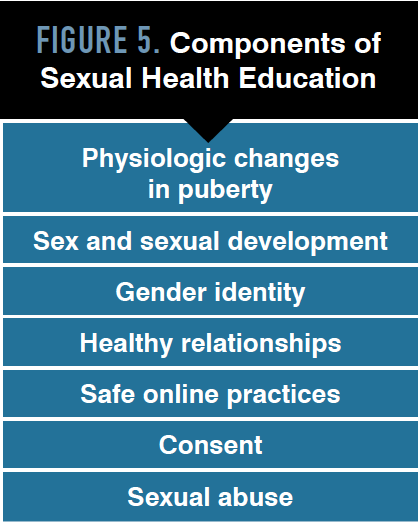
Although these topics can be time-consuming to discuss, they can have a profound positive impact on adolescents whose sexuality is often ignored. Help from other providers (nurse practitioners, social workers, sexual health educators) can ensure that patients get adequate age- and development-appropriate teaching. It is imperative to assess an adolescent’s level of cognition, and have at least some discussions of sexual health privately, without the presence of family, if deemed appropriate. In today’s era of virtual visits, it can be challenging to ensure this level of true privacy. Office visits, where both patients and providers can be confident in the privacy of the exam room, may be superior for visits regarding sexual health education.
Teens with disabilities can be vulnerable to abuse and exploitation because of social isolation and restrictions on their reproductive rights. If apt, it is important to discuss with patients what types of touching are inappropriate and to develop a plan they can carry out if they do experience inappropriate touching. In the era of constant online connectedness, both patients and families must be involved in discussing ways to ensure online communication is consensual, safe, and appropriate.
Conclusions
As health care providers, we are uniquely positioned to be involved with and improve the reproductive health care and education of patients with disabilities. It is imperative that we treat all patients equally, offering all sexual and reproductive services regardless of whether a patient has a disability.
References
1.Disability and health information for women with disabilities. Centers for Disease Control and Prevention. September 16, 2020. Accessed May 12, 2022. https://www.cdc.gov/ncbddd/disabilityandhealth/women.html
2.Increase in developmental disabilities among children in the United States. Centers for Disease Control and Prevention. May 16, 2022. Accessed May 16, 2022. https://www.cdc.gov/ncbddd/developmentaldisabilities/features/increase-in-developmental-disabilities.html
3.Smeltzer SC, Mitra M, Long-Bellil L, Iezzoni LI, Smith LD. Obstetric clinicians' experiences and educational preparation for caring for pregnant women with physical disabilities: a qualitative study. Disabil Health J. 2018;11(1):8-13. doi:10.1016/j.dhjo.2017.07.004
4.Wu JP, McKee MM, McKee KS, Meade MA, Plegue M, Sen A. Female sterilization is more common among women with physical and/or sensory disabilities than women without disabilities in the United States. Disabil Health J. 2017;10(3):400-405. doi:10.1016/j.dhjo.2016.12.020
5.Legano LA, Desch LW, Messner SA, et al. Maltreatment of children with disabilities. Pediatrics. 2021;147(5):e2021050920. doi:10.1542/peds.2021-050920
6. Iezzoni LI, Mitra M. Transcending the counter-normative: sexual and reproductive health and persons with disability. Disabil Health J. 2017;10(3):369-370. doi:10.1016/j.dhjo.2017.04.001
7. Ballan MS, Freyer MB. The sexuality of young women with intellectual and developmental disabilities: a neglected focus in the American foster care system. Disabil Health J. 2017;10(3):371-375. doi:10.1016/j.dhjo.2017.02.005
8Wisdom JP, McGee MG, Horner-Johnson W, Michael YL, Adams E, Berlin M. Health disparities between women with and without disabilities: a review of the research. Soc Work Public Health. 2010;25(3):368-386. doi:10.1080/19371910903240969
9.American College of Obstetricians and Gynecologists’ Committee on Adolescent Health Care. Committee Opinion No. 668: Menstrual manipulation for adolescents with physical and developmental disabilities. Obstet Gynecol. 2016;128(2):e20-e25. doi:10.1097/AOG.0000000000001585
10.Crinò A, Schiaffini R, Ciampalini P, et al. Hypogonadism and pubertal development in Prader-Willi syndrome. Eur J Pediatr. 2003;162(5):327-333. doi:10.1007/s00431-002-1132-4
11. Almutlaq N, O'Neil J, Fuqua JS. Central precocious puberty in spina bifida children: Guidelines for the care of people with spina bifida. J Pediatr Rehabil Med. 2020;13(4):557-563. doi:10.3233/PRM-200728
12.May T, Pang KC, O'Connell MA, Williams K. Typical pubertal timing in an Australian population of girls and boys with autism spectrum disorder. J Autism Dev Disord. 2017;47(12):3983-3993. doi:10.1007/s10803-017-3281-3
13.Patel DR, Greydanus DE, Calles JL Jr, Pratt HD. Developmental disabilities across the lifespan. Dis Mon. 2010;56(6):304-397. doi:10.1016/j.disamonth.2010.02.001
14.Kirkham YA, Allen L, Kives S, Caccia N, Spitzer RF, Ornstein MP. Trends in menstrual concerns and suppression in adolescents with developmental disabilities. J Adolesc Health. 2013;53(3):407-412. doi:10.1016/j.jadohealth.2013.04.014
15Fei YF, Ernst SD, Dendrinos ML, Quint EH. Preparing for puberty in girls with special needs: a cohort study of caregiver concerns and patient outcomes. J Pediatr Adolesc Gynecol. 2021;34(4):471-476. doi:10.1016/j.jpag.2021.03.008
16.Daunov M, Rondinelli J, Ahuja SP, Stehouwer NR. Prevalence of venous thromboembolism in ambulatory and non-ambulatory patients with cerebral palsy. Blood. 2019;134(suppl 1):2428. doi:10.1182/blood-2019-130622
17Spentzouris G, Scriven RJ, Lee TK, Labropoulos N. Pediatric venous thromboembolism in relation to adults. J Vasc Surg. 2012;55(6):1785-1793. doi:10.1016/j.jvs.2011.07.047
18ACOG Practice Bulletin No. 110: noncontraceptive uses of hormonal contraceptives. Obstet Gynecol. 2010;115(1):206-218. doi:10.1097/AOG.0b013e3181cb50b5
19Michielsen K, Brockschmidt L. Barriers to sexuality education for children and young people with disabilities in the WHO European region: a scoping review. Sex Educ. 2021;21(6):674-692. doi:10.1080/14681811.2020.1851181
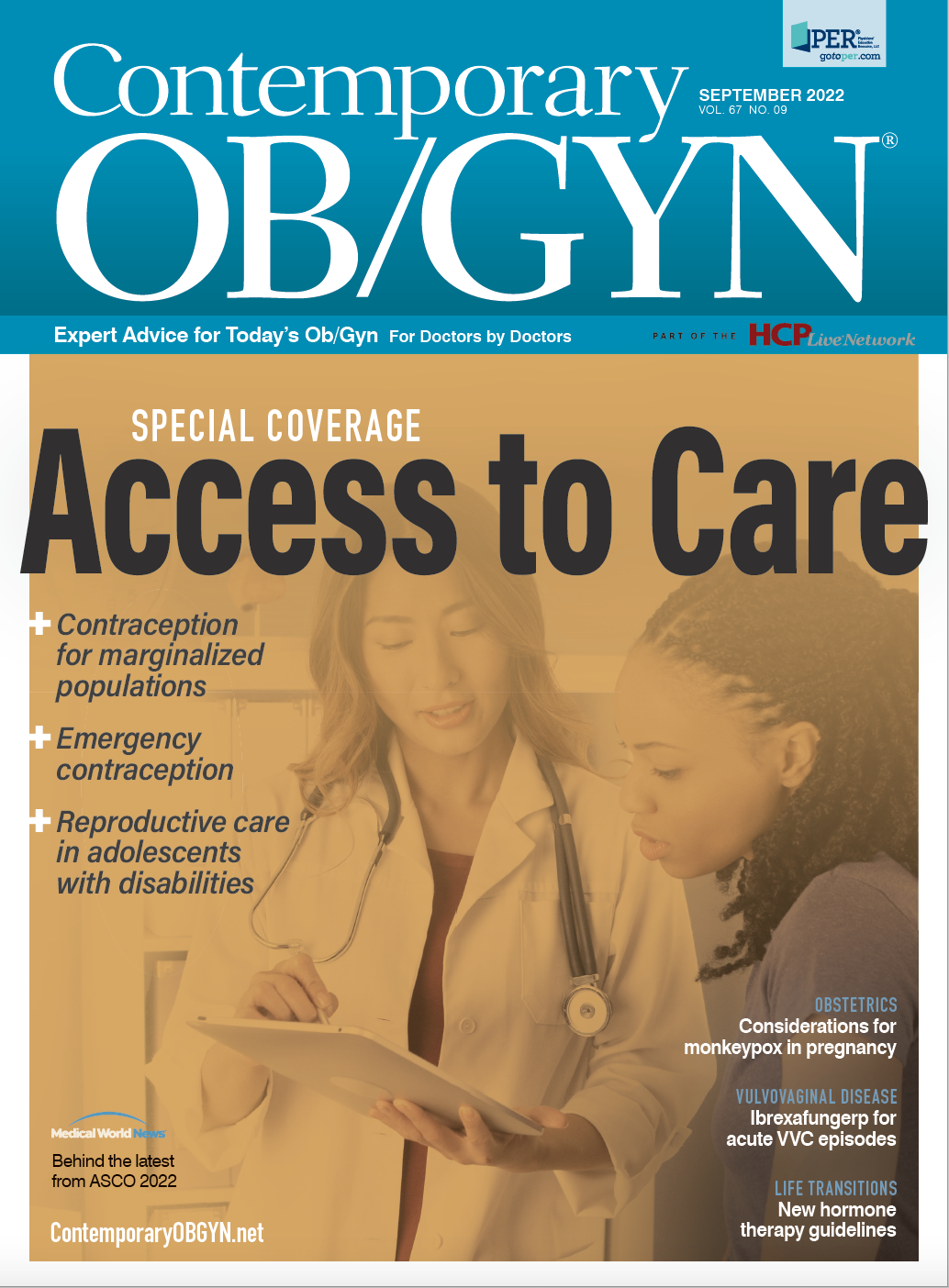
Newsletter
Get the latest clinical updates, case studies, and expert commentary in obstetric and gynecologic care. Sign up now to stay informed.
